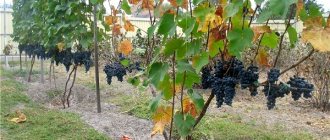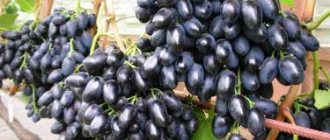Grapes are considered a crop with traditional forms. Exotics are more common in other berries. But American breeders surprised gardeners by creating a hybrid grape variety and a Mediterranean type of berry. As a result, the amazing grape “Witch Fingers” was born. Not only the name, but also the appearance of the grapes is unique.
It was grown for the first time in 2001. Currently, the plantations of this grape variety are located in the state of California in a vineyard in the San Joaquin Valley. This is the only place where a unique hybrid is grown. Californian breeders presented an interesting table variety with unusual berries. It's worth getting to know him better. Therefore, the description of the variety, photos and reviews of the “Witch’s Fingers” grapes will be useful to everyone who is going to grow it on their plot.
It is almost impossible to purchase seedlings in Russia; they are only available from Western breeders. If you come across an advertisement: “I’m selling Witch’s Fingers grape seedlings,” be sure to ask where they were grown. It should be noted that in Kuban this variety is already available in some areas and gardeners are very pleased with their purchase.
More details in the video:
Description
The grape variety “Witch Fingers”, or “Witch Fingers”, belongs to the elite table vine species.
These red varietal grapes are eaten fresh. For many ordinary people, it raises doubts about the use of genetically modifying technologies or chemicals by manufacturers. However, the authors claim that the unusual shape is only the result of selection, and the final product does not pose any danger. There is a high probability that this variety will become widespread within the Russian Federation as soon as it becomes possible to purchase seedlings.
If you wish, you can purchase an analogue of this hybrid. It is called “Alyonushka” and is available in the CIS countries. The difference is that the “double” fruits have small seeds, which can be eliminated by applying Gibberellin.
Bush
Has high growth vigor. The vine needs the construction of two-level trellises, 2-3 m high. The vines are light brown in color, and the young shoots are light green. The leaves are round and large. They have 5 blades separated from each other by large notches. The color is even, light green.
The flowers are bisexual, which allows the bush to exist absolutely autonomously.
Fruit
The grapes attract attention first of all. This variety got its name due to the similarity of the fruits to the crooked female fingers - oblong, thin, slightly curved and pointed at the end.
There is also a parallel name to “Chili”, because the grapes are shaped like this pepper.
The clusters are impressive in size, can reach 0.7-1.5 kg. They have a regular pyramidal shape and medium density.
The berries are large. They have dimensions of about 10X30 mm, which corresponds to the tubular shape of the fruit. The weight of one is 7-10 g. The pulp is very juicy, with a pleasant crunch, covered with a dense skin. The color of the grapes is uneven, dark blue or black-violet, darker towards the periphery. There may be notes of burgundy color, which fade with ripening. Each berry is coated with natural wax, which makes the color a little lighter and gives it a matte finish. The insides have a light dark color.
The taste is bright but harmonious, with strong sweetness and low acidity. Some winegrowers compare it with the Labrusca variety, although this is not entirely true. In the case of Witch's Fingers, the delicate plum flavor is very pronounced. The aroma reveals notes of duchess and fresh apples. The skin adds some sourness, but this only adds brightness to the taste.
At the moment, purchasing these grapes is possible from American breeders
Maturation
This species has early or medium ripening. From the beginning of the growing season to harvest, 115-125 days pass. Ripening occurs in the middle third of July.
Climatic conditions
“Witch’s fingers” can easily withstand winter temperatures down to -20-250C. If more significant frosts are expected, then care should be taken to carefully cover the vines. This makes it possible to grow it not only in regions with temperate but also in harsh climates.
Resistance to diseases and pests
Being a true miracle of selection, it has increased or moderate resistance to most vineyard diseases.
- and penosporosis are among the main problems of viticulture, but this variety has a high level of resistance to them. Despite this, many experts recommend carrying out preventive treatments with colloidal sulfur, Tiovit-Jet, Topaz, Skor, etc. To prevent infection, waterlogging of the soil should be avoided. The plant should be planted in well-lit and ventilated areas.
- Bacterial canker rarely affects this vine. A disease in which air blisters appear on the stems can become a serious problem and cause the death of the plant. For treatment and prevention, Extrasol, Fitoplasmin, Gamair, Fitolavin and others are used.
- Wasps do not pose a real threat, as they do for most table species with a high sugar content. The thick skin protects the berries from damage by insects.
- Birds can cause the destruction of the entire crop. Homemade “noise makers” or scarecrows can solve this problem. A more likely effect will be achieved by means of mechanical protection (special nets placed on the bunches) and professional ultrasonic repellers.
- Rodents can be controlled by scattering ash, peat with creolin or sawdust around the bush. Raticides may also be useful to you. However, it should be remembered that such products must be safe for people and pets.
Growing and further care
The process of caring for the variety in question is quite labor-intensive, but not complicated. Regular attention and care will make it possible to obtain not only large and tall bushes, but also well-bearing bushes. To do this, the vineyard needs to create an optimal microclimate, carry out timely pruning, and fertilizing.
Watering and fertilizing
In spring, watering is carried out once a month; in summer, the frequency is increased to 2 procedures per month. The last time the bushes are watered is in late autumn, 2 weeks before the bush is prepared for wintering. Use only clean, well-settled water for irrigation. It should not be cold, so it is heated in the sun to the temperature of the natural environment.
Important! After watering, the root ring of the bush must be mulched with wood ash, old bark or pine needles
-
this helps to avoid instant loss of moisture from the soil.
"Witch's fingers" respond well to regular feeding. In spring, the plant needs nitrogenous compounds, and during flowering and fruiting, it needs freely available potassium and phosphorus. To avoid a deficiency of these substances, the bushes are fertilized at least 3 times per season. In early spring, 50 g/m² of ammonium nitrate is added to the soil; before flowering and during the formation of the ovary, the bushes are fertilized with 40 g of superphosphate and 20 g of potassium sulfate.
Mineral fertilizers are applied in the form of solutions: for this, one portion is dissolved in 10 liters of water. Once every 3 years, the vineyard is fed with organic substances - the procedure is carried out in the fall, a solution of cow manure (1:10) is used as fertilizer.
Bush formation and pruning
Formation and pruning are carried out several times per season. For the first time in the season, the vine is pruned in the spring - at this time old and frozen shoots are removed. As the bush develops, the stepsons on it are removed. During the development of clusters, the bushes are normalized to avoid overweight of the bush and shading of the clusters by each other. To speed up the ripening of grapes, it is also recommended to remove foliage that shades the berries.
Read more about proper pruning of grapes in spring.
In the fall, sanitary pruning and shortening are carried out; in addition to old shoots on the bush, all fruit-bearing shoots are removed. This is done in such a way as to give the bush a shape convenient for shelter, while at least 5-6 eyes should remain on each fruit-bearing shoot.
The formation of the crown of the bush is carried out during sanitary pruning, in early spring and late autumn. The procedure makes it possible to create a form that is convenient for care, development and fruiting. In addition, formation makes it possible to create an optimal ratio between the above-ground and underground parts of the bush, which directly affects its productivity. The bush is formed in such a way that 3–4 main shoots grow from the root zone, consisting of many one- and two-year-old branches.
Weeding the soil
Weeding the soil has several meanings for the grapevine - it helps:
- saturate the roots with air;
- establish an optimal water regime in the root zone;
- avoid the development of weeds on the site, which negatively affect the development of bushes.
Loosening is carried out in two ways: deep and superficial.
Deep plowing is carried out 2 times a season, in early spring and late autumn. At this time, the soil is loosened to a depth of 25–30 cm. Surface loosening is done as necessary, the next day after watering and while weeding, the plowing depth should be about 10–15 cm. During loosening, thorough treatment is carried out only the trunk circle, but also the row spacing. Important! To protect against damage to the crop by small birds or rodents, sawdust, peat, ash or fresh pine needles should be placed around the bush a meter from the trunk. They secrete specific substances that repel small pests.
Shelter for the winter
Shelter for the winter is a mandatory measure for those regions where there is a danger of winter frosts below –15°C. This procedure is carried out in late autumn, after the average daily temperature reaches +10°C.
Covering is done in several stages:
- First, the root zone is covered with a thick layer of soil about 50 cm thick. Thus, the root circle needs to be turned into a small earthen mound that protects the roots from freezing.
- Next, the plant undergoes sanitary pruning and shortening, after which the branches are tightly tied with rope. If the bush is tied to a support, then it is freed.
- The tied bush is pressed to the soil and then covered with burlap or special agrofibre. A layer of dense polyethylene is laid on top of such materials, which is covered with 10–15 cm of sawdust, bark or light varieties of soil.
Covered grapes must be covered with snow - this measure significantly increases the thermal insulation properties of the protective shelter.
Specifications
When growing grapes, it is necessary to take into account its technical properties and susceptibility to various environmental conditions.
Creating an environment favorable for the growth of berries has a positive effect on the quality and quantity of the harvest.
Frost resistance
The plant is heat-loving, frost resistance is average. The bushes are able to endure temperature drops down to -23 degrees. On the eve of frost, it is recommended to remove the vines from the trellis and protect them from the cold with the help of covering material.
Climatic conditions of growth
The variety is unpretentious in care and can withstand the climatic conditions of central Russia, while demonstrating high yields. It is possible to grow Witch's fingers both on an industrial scale and in private areas.
Optimal growing conditions
The mild climate of California makes it possible to obtain a second wave of the Witch's Fingers crop. The high price of grapes of this variety dictates the full load of the harvest on the bushes. In Russia, they usually practice complete removal of stepsons and harvest in one wave.
Sea buckthorn: planting and care, pruning and picking berries
The need to prepare grapes for winter and allow the young vine to ripen requires normalizing the seasonal load in a temperate climate. The frost resistance of the crop allows, with the correct agricultural technology, to grow Witch's fingers in the Black Sea region, in the south and even in the central regions of Russia.
The variety, according to gardeners, is quite demanding in terms of care and is capable of showing high yields only in the hands of experienced winegrowers. Witch's fingers grapes are not suitable for first-time experimentation by beginners. The culture is not unpretentious. The entire range of work on care, feeding, protection and preparation for winter will need to be completed in full.
Grapes have certain characteristics that you should know before planting. Having studied all the requirements of the Witch's Fingers variety, you can start growing it in a private garden or on a commercial plantation.
Green Witchfingers
This pastry is prepared according to the following recipe:
- Using a mixer, beat butter (200 g) with powdered sugar (1 tbsp) into a creamy mass.
- Beat 1 raw egg, add vanillin, green coloring (5 drops), baking powder and salt (1 teaspoon each).
- Gradually sift the flour (340 g) and knead the dough. Before sculpting the “fingers” it needs to be cooled well.
- Roll out “sausages” from the dough, corresponding in size to real fingers.
- Place almonds in place of the nail.
- Cook the “Witch’s fingers” cookies at 180°C until done.
- It is necessary to remove the “nail” from each “finger”, grease the indentation with jam and carefully return the almonds to their place.
Breeding and planting
When planting and further growing grapevines, a number of rules must be followed. In order to consistently obtain a healthy and large harvest, you need to choose a suitable seedling, decide on its location and provide constant care.
Selection of seedlings
When choosing a seedling with an open root system, it is recommended to take into account several nuances. In particular:
- The color of the roots should be light. If the main part of the roots has darkened, then the bush will most likely not take root and will rot.
- After treatment with pruning shears, the cut root should be creamy in color.
- There should be no thickening or visible damage on the roots, indicating infection or pest damage.
Planting pattern and depth
A grape plantation is started, starting with the choice of location. For the Witch's Fingers variety, sunny areas protected from draft winds and flooding are suitable. It is recommended to leave a distance of 1-1.5 m between bushes.
The soil is prepared by plowing to a depth of 60-80 cm. The depth of the hole for placing the seedling is also up to 80 cm, and the width is about 1 m.
Feeding young shoots
For intensive plant development, fertilizing is required when planting a seedling. Compost, mineral fertilizers and rotted manure are placed at the bottom of the dug hole. The soil is diluted with coarse sand and black soil.
Tips for caring for crops
Regular and proper care is the key to obtaining a high-quality harvest. Caring for vineyards involves constant inspection for timely detection of diseases, soil cultivation, fertilizing and elimination of unfavorable factors.
Loosening the soil
Deep loosening of the soil is carried out every autumn. The earth is dug up to a depth of about 1 m in order to mix the lower and upper layers. As a result of thorough loosening, the soil is completely saturated with nutritional components, which are transferred to the roots of the plant. In addition to deep loosening, it is recommended to periodically loosen the top layer of soil so that liquid and precipitation do not stagnate.
Regularity of watering
It is important to maintain regular watering of the Witch's Fingers variety, since a lack of liquid leads to insufficient development of bushes and a reduction in yield. Overmoistening of the soil provokes rotting of the roots, as a result of which the plants die
When growing young seedlings, a hole is formed and watering is carried out only within its boundaries.
After the vines grow, water the ground under the bushes. During the season, the soil is moistened several times, observing the external condition of the plants. Immediately after planting, the seedlings are watered once a week, reducing the frequency over time.
Fertilizer
Grapes require complex fertilizers with a high content of nitrogen, phosphorus and potassium. The substances are responsible for stimulating the growth of green mass, the formation of inflorescences and ovaries, increasing resistance to frost, increasing the amount of yield, and improving taste characteristics.
The first fertilizer is applied at the stage of planting grapes. Then you need to fertilize the plants in the spring for active growth and 10 days before the formation of ovaries. 3-4 weeks before harvest, final fertilizing is used to increase fruit weight and improve shelf life.
Treatment against infections and pests
Despite the resistance of the Witch's Fingers variety to diseases, if care rules are violated or the climate is unfavorable, there is a risk of developing an infection or attack by harmful insects.
Signs of grape damage are:
- dark spots on leaves;
- mold formation;
- root rotting;
- the appearance of plaque on the green part of the plant.
To protect the bushes and for preventive purposes, it is necessary to spray the plants with insecticidal and fungicidal preparations. Large pests can be removed from green spaces yourself.
Pruning and shaping the vines
Pruning of the vine is required to ensure sufficient sunlight and air reach the grapes. The plant can be formed in the spring, when the risk of return frosts has disappeared, or in early autumn. During the pruning process, old branches, rotten leaves and excess green matter are removed. The secondary purpose of shaping grapevines is to provide a decorative appearance.
Pest control and disease prevention
Selection work to develop the Witch's Fingers variety has provided plants of this species with stable immunity to pests and diseases. In cold climates, conditions may arise where plants become weakened. Therefore, in the case of growing plants of the Witch Fingers variety, it will be necessary to use drugs to protect against downy mildew, spotting, and bacterial canker - the most common diseases of grapes in temperate climates.
New grape varieties that gardeners want to have in their vineyards are not always available. A striking example of this is Witch’s Fingers, which is growing only in the USA so far. But many people independently begin to try to carry out breeding work in the direction that suits their desires and achieve good results.
Plant care tips
The variety is elite and quite capricious. Requires a special approach
Pay attention to the advice of experienced winegrowers on caring for the vine:
- Watering. First of all, it is necessary to maintain the soil moisture level. After planting, during the first year of development, the seedling is watered 2 times a month with non-cold water.
- Mandatory monthly watering of adult bushes is recommended.
- During the flowering period, grapes should not be watered.
- 2 weeks before the onset of cold weather, it is necessary to carry out the last watering.
- nitrogen - in spring,
- After the leaves bloom.
To get a full harvest, you must follow these tips.
Planting and growing the Witch's Fingers grape variety
Many people have a desire to have Witch's Fingers grapes, but today they are grown only in Kern County, California. You can purchase seedlings of this variety for home gardens only in the USA. Let's hope that after some time they will be more accessible, and then there will be experience in growing this variety in Russia and other European countries.
Important! Today, it is difficult to give clear recommendations and advice on agricultural cultivation techniques, because it is unknown how the variety will behave in unusual climatic conditions.
If you rely on the information from the manufacturer of the variety, you can note that its requirements for growing conditions are approximately the same as those of other elite grape varieties:
- The variety is photophilous and requires good air circulation. Since the bush is vigorous, it needs pruning, which is carried out at the end of winter or early spring, but before the grapes begin to grow;
- the preferred soil for growing is slightly acidic;
- requires watering (at least once a month) with the exception of the flowering period. The last (moisture-charging) watering is carried out 2 weeks before the onset of frost. It increases the cold resistance of the plant;
- It is recommended to mulch the plantings with moss or sawdust, which slow down the evaporation of moisture and suppress the growth of weeds;
- Before wintering, the vineyard is fertilized with compost or humus. It is recommended to apply nitrogen fertilizers in the spring, and potassium and phosphorus fertilizers in the summer;
- the vine should be covered for the winter;
- During the growing season, it is recommended to carry out at least two preventive treatments with a fungicide solution. The first spraying is carried out after the leaves bloom, and the second - during the period of fruit ripening.
Biscuit dough
1. Carefully separate the whites from the yolks.
2. Add ¾ of sugar to the yolks and grind until the grains disappear and the mass increases 3 times in volume.
3. In another bowl, beat the egg whites without sugar. If they are not whipped well, you need to cool them, add a little salt, citric acid or a few drops of vinegar. The whites should be beaten slowly, gradually increasing the speed.
BTW: attention! The dishes must be completely clean! Egg whites do not whip well if they contain a little fat or yolk. 4
At the end of whipping, add sugar.
4. At the end of whipping, add sugar.
5. When the whites increase in volume by 4-8 times and do not spill out when the bowl is tilted, stop beating. Excessively beaten egg whites will “sag” the dough during baking.
6
Add 1/3 of the beaten whites to the mashed yolks, mix carefully, and while stirring, add flour or flour with starch.
7. After this, add the remaining whites.
8. Bake the dough immediately after kneading. Grease a mold or baking sheet with cold butter, sprinkle with flour, or place a sheet of white paper, following the same procedure. Fill the mold with dough to ¾ of the height, as it will increase in volume during baking. Bake for 25-30 minutes at 200-220°C.
BY THE WAY: do not touch the biscuit for the first 10-15 minutes! It may shrink or not bake well.
9. The finished sponge cake is easily separated from the walls of the mold. When pressed with a finger, the dimple quickly levels out, the upper crust is golden in color. The finished biscuit is left in the oven for some time. Leave for about a day so that the dough is pliable for further preparation.
How to care.
Witch's fingers are not unpretentious varieties that do not require attention. You will have to take care of him and spend your time.
Watering rules
A suitable watering regime is very important for this variety. An adult specimen needs to be watered approximately once every twenty-five to thirty days. The water should be soft, clean, and at room temperature. It is best to water at the end of the day, that is, in the evening. When the plants begin to bloom, watering should be postponed, because excessive soil moisture causes the risk of dropping buds, and, accordingly, a decrease in the future yield. The last watering should be done about ten to fifteen days before the cold weather sets in. The last watering is very important for plants, because it is a moisture-recharger and cannot be skipped. It will help ensure abundant harvests next year. It will also help increase frost resistance. If the grape specimen is young, then it needs to be watered once every ten to fifteen days.
About mulch
The trunk circle of the plant must be mulched. This will help retain moisture and also protect the plant from weeds. When choosing a mulch layer, you need to pay special attention to sawdust or moss.
Fertilizers and fertilizers
The witch's fingers variety needs regular feeding and fertilizer. In spring, it is recommended to apply fertilizers with nitrogenous elements. In the summer, it is recommended to fertilize with phosphorite and potassium elements. For fertilizers in spring, for foliar feeding, you can use a universal complex mineral fertilizer for fruit and berry plants.
During the ripening of the berries, the bush needs to be fed with fertilizers containing potassium and phosphorus elements. Foliar feeding will also be useful for the berry garden. For example, it can be done like this:
- ten liters - clean water, room temperature;
- forty grams of superphosphate;
- twenty grams of potassium sulfate.
All these components must be thoroughly mixed and sprayed on the foliage part of the plant. With the arrival of the autumn period, this feeding needs to be repeated. Organic fertilizers can be applied directly to the soil in the autumn. This needs to be done approximately once every three years. The recommended time is when all the leaves have fallen. Also, fertilizing should be done during watering so that the bush does not get burned.
Description and main characteristics of the Witch's Fingers variety
The variety received its main name due to the unusual shape of the berries. They are bizarrely curved and look like elongated and curved fingers. Others saw in the grapes a resemblance to small pods of hot pepper and gave the variety a parallel name - Chile. When describing a variety, the following characteristics must be noted:
- the manufacturer declares the variety as a dessert hybrid of sultanas;
- the variety has ordinary grape leaves;
- the vine is powerful with great growth force, so it will need pruning;
- flowers are bisexual, capable of self-pollination;
- the color of the berries can be dark blue, black-blue or deep purple;
- peel without shine, strong, taste without sourness;
- the pulp is juicy and crisp;
- the taste of the berries is specific, sweet, slightly reminiscent of plum;
- Apple-pear berry aroma.
Note! The variety is intended for fresh consumption. Long-term storage and heat treatment are detrimental to the beneficial properties of Witch's Fingers grapes
In the USA, one kilogram of Witch's Fingers grapes costs about $20
Table: main characteristics of the Witch's Fingers grape variety
| Purpose | The variety belongs to table, red |
| Ripening time | Mid-season. Ripening begins approximately 4 months after the leaves bloom |
| Productivity | Average |
| Cold resistance | Withstands frosts down to -23 degrees |
| Resistance to pests and pathogens | High enough |
| Brush weight | From 0.6 to 1.5 kg |
| Berry weight | From 7 to 15 g |
| Acidity | Low, per 1 liter of juice - 6–7 g of acid |
| Sugar content | 19–21% |
Witch's fingers grapes form large conical clusters
Note! The fruits of the Witch's Fingers grape variety contain a high percentage of ascorbic acid, sugars, fiber, and various vitamins. Its calorie content is 95 kcal per 100 g of product.
The variety exhibits increased resistance to most grape diseases. Manufacturers claim that it is sufficiently resistant to downy mildew and bacterial canker, the most common fungal diseases. This is due to the high percentage of sugar and low acid content. Since Witch's Finger berries have a dense skin, wasps do not pose a threat to the variety. The main pests are birds and rodents, which winegrowers fight with proven means: installing birdbaths, traps and barriers for mice, and using poisonous baits.
Reproduction Witch Fingers
On the Russian-language Internet you can find reports that grains of the Witch's Fingers grape variety brought from the USA were planted in the ground. From them seedlings grew, which successfully took root in the open ground; after 3 years, the first clusters with berries of apple and pear flavor were removed from them. This only means that the grape seeds that came to Russia belong to some other grape variety grown in the USA. In fact, the original variety, Witch's Fingers, is seedless.
For your information! English-language propagation sites for the original Witch Fingers say that once it becomes available for cultivation by amateur gardeners, it can be propagated by cuttings and grafting the cuttings onto the rootstock.
Butter cream
1. Pour milk into the pan, add sugar, stirring, bring to a boil so that the sugar is completely dissolved.
2. In a separate bowl, lightly whisk the eggs and, continuing to whisk, pour in the hot milk and sugar in a thin stream.
3. Bring the resulting mixture to a boil.
4. Then cool to room temperature.
5. While the mixture is cooling, beat the butter with vanilla powder and pour in the milk mixture. Beat until fluffy.
BY THE WAY: you can add any additives to this cream if you wish.
Preparation of Witch's Fingers:
1. Bake the biscuit, cool, and grind through a meat grinder.
2. Mix biscuit crumbs, cognac, and butter cream.
3. Divide the resulting mass into parts and shape them into fingers.
4. Add green food coloring.
5. Cool.
6. Melt the chocolate. Drizzle hot chocolate onto the side of the nail bed.
7. Add almonds.
6. Refrigerate until firm.
Cookies "Witch's fingers"
RECIPE FOR “WITCH FINGERS” COOKIES Option two - thin and less calorie
HOW TO COOK:
1. Add powdered sugar, egg white to softened butter and knead the dough for 5-8 minutes.
2. Divide in half and add cocoa powder to half of the dough and knead.
3. Place the prepared dough in a pastry bag with a straw and pipe it onto a baking sheet in the form of fingers.
4. Make indentations on the side of the nail bed.
5. Bake for 10-12 minutes at a temperature of 200-220°C.
6. After baking, pour hot chocolate into the hole for the nail bed, place the almond there and let cool.
“Witch fingers” for your friends is ready!
Cookies "Witch's fingers"
Botanical description
The Witch's Fingers grape is included in the category of red table grapes. The grape vines are vigorous and are often used for decorative purposes. The flowers are hermaphroditic and are capable of self-pollination. According to the time of ripening, the variety is classified as early ripening.
Bush
With proper care and favorable climatic conditions, grape bushes grow tall, dense and strong. Due to the large amount of foliage, the bushes require periodic pruning.
Appearance and taste of fruits
The shape of ripened fruits is tubular, oblong. The color is dark blue, gradually turning into purple with black accents. The surface of the fruit is matte.
Characteristics of bunches and berries
“Tear Drops” brushes have a beautiful elongated cylindrical or cylindrical-conical shape, reaching 25-40 centimeters in length. Their density is medium or loose. The mass of the brushes is from 400 to 800 grams.
The berries are shaped like bent little fingers or chili peppers. Their dimensions reach 50-53 mm in length and 8-12 mm in width. The weight of the berry is 8-10 grams. The color of the grapes, depending on the stage of ripeness, ranges from red-pink to blue-violet. The berries are covered with a thin coating of pruin. Sugar accumulation in “Funny Fingers” is quite high, 17-19%, with an acid content of 6-8 g/l.
Preparing for winter
In the first years of life, it is better to cover the grapes for the winter. To do this, the plant is first prepared in mid-October: the remaining leaves, dry branches, and lower shoots are cut off. The soil is loosened and humus or compost is sprinkled on it. Then the plants are covered with agrofibre or film. The material must be pressed on top with a weight so that the grapes will last all winter.
With the arrival of spring (not earlier than April), the vineyards open. They get rid of frozen branches and renew shoots. To quickly gain green mass, you can feed the crop with any nitrogen fertilizer (nitrate, ammophos). Dilute 1 tbsp. fertilizers in a bucket of water and water the bush with it at the root. The treatment is repeated after 10 days.
Collection and storage
Table grapes are consumed fresh. It cannot be stored for a long time, a maximum of a couple of days in the refrigerator. It is better to eat the original variety of perishable sultanas as soon as the berries have been purchased or picked from the bush.
Advice: It is not advisable to treat witch fingers thermally.
The ripening period of American grapes is early or medium. The Witch's Fingers fruit is usually harvested in mid-summer. The first harvest is harvested 115 or 125 days from the moment the growing season begins. The grapes ripen in July, towards the end of the month. Since the variety is not long-lasting, you can sell off the surplus harvest to friends, neighbors, etc. In addition to delicacies, the troubles will also bring profit.
Description of the variety
“Witch’s fingers” is a table red seedless hybrid of the “kishmish” species. Belongs to the category of elite varieties. The second name of the grape is “Chili”, as the berries resemble small peppercorns.
The bush is powerful with active growth force, so pruning is required.
The fruits are rich blue in color, turning into dark purple or even black. The pulp is juicy and crispy. The skin is strong, you can feel it when eating, but it does not sour. The surface of the berries is matte, slightly covered with a waxy coating. The taste is rich, sweet with a prune flavor. The aroma is bright - a mixture of duchess, nutmeg and apple. The weight of the berries is 7-10 grams. It differs from other varieties in low acidity and a small proportion of tannins.
The growing season is 115-125 days, this is a characteristic of early ripe grapes. The flowers are bisexual, so no additional pollination is required.
The clusters are large, weighing up to 680-1500 grams.
Frost resistance is quite good, the vine will withstand temperatures dropping to -23 C°. This suggests that grapes of this variety can be grown in central Russia. The fruits are recommended to be consumed fresh. Theoretically, Witch's Fingers can also be used for recycling. But this is impractical, since the yield is not too high, and cheaper raw materials can be used for winemaking.
It is still impossible to buy seedlings of this unique hybrid in our country; they are simply not available for sale. For those winegrowers who want to have a variety similar in external characteristics and taste, we can recommend the “Alyonushka” variety.
What type is the variety?
Witch's fingers grapes are red table varieties, so they are recommended to be consumed fresh, without undergoing any processing. It is also a hybrid form of the “raisin” species, that is, even despite its large size, the berries contain a very small number of seeds.
Many winegrowers classify this variety as elite, due to its small distribution around the globe and, accordingly, the small volume of the harvest.
But Russian summer residents also have the opportunity to grow unusual berries on their plot. There is a hybrid twin of the “witch’s fingers” grape variety called “alyonushka”. It is widespread throughout the country and is much easier to acquire.
How the Witch's Fingers variety was developed
The Witch's finger subspecies was first bred by a group of breeders at the University of Arkansas at their research base in California. It was created by crossing American grapes with different varieties of Mediterranean origin. Breeders used hand pollination techniques. The result was a grape with blue berries shaped like elongated and curved fingers. The grapes are also similar to hot peppers, which is why the second name of the Chili variety is known.
During selection, the grapes were not subjected to any genetic modifications; they are completely natural.
You can eat Witch's finger berries without harm to your health, enjoying their unusual taste.
History of the variety
Due to the fact that when growing the most popular varieties of vegetables, fruits, and berries, overproduction often occurs, it becomes unprofitable for gardeners and vegetable growers to sell their goods. Too much supply sometimes makes viticulture unprofitable.
Therefore, the American campaign International Fruit Geneties, after carrying out breeding work in 2002 to develop a new type of grape, which became known as Witch Fingers, did everything possible to prevent plant seedlings from going on sale without a proprietary license. It is also impossible to propagate grapes by seeds, because they are seedless crops.
But the popularity of this type of grape is growing every year, despite the fact that at first American consumers were not very willing to buy berries with a rather scary name. After the variety was renamed, it began to go on sale under other names. The Witch Fingers grape was first renamed Funny Fingers, and then, after additional breeding work, Tear Drops.
Important! Tear Drops berries for the American market are grown only in California, in the San Joaquin Valley.











